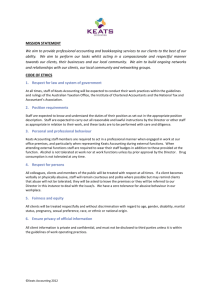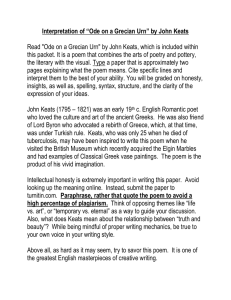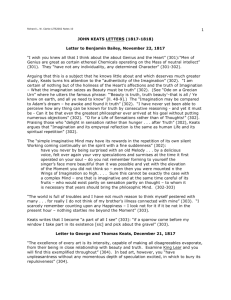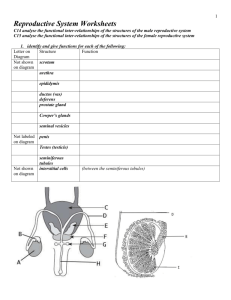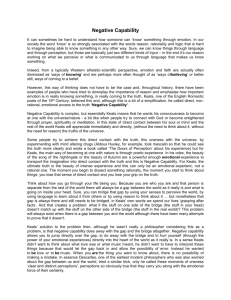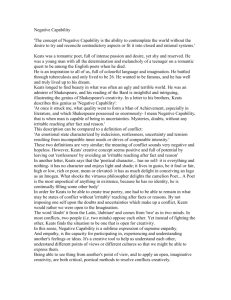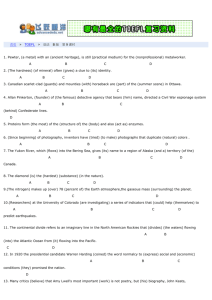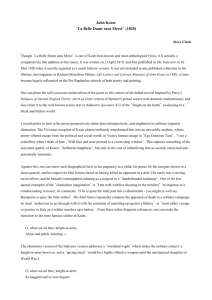Recalling Adam's Dream A note on Keats and Cowper
advertisement
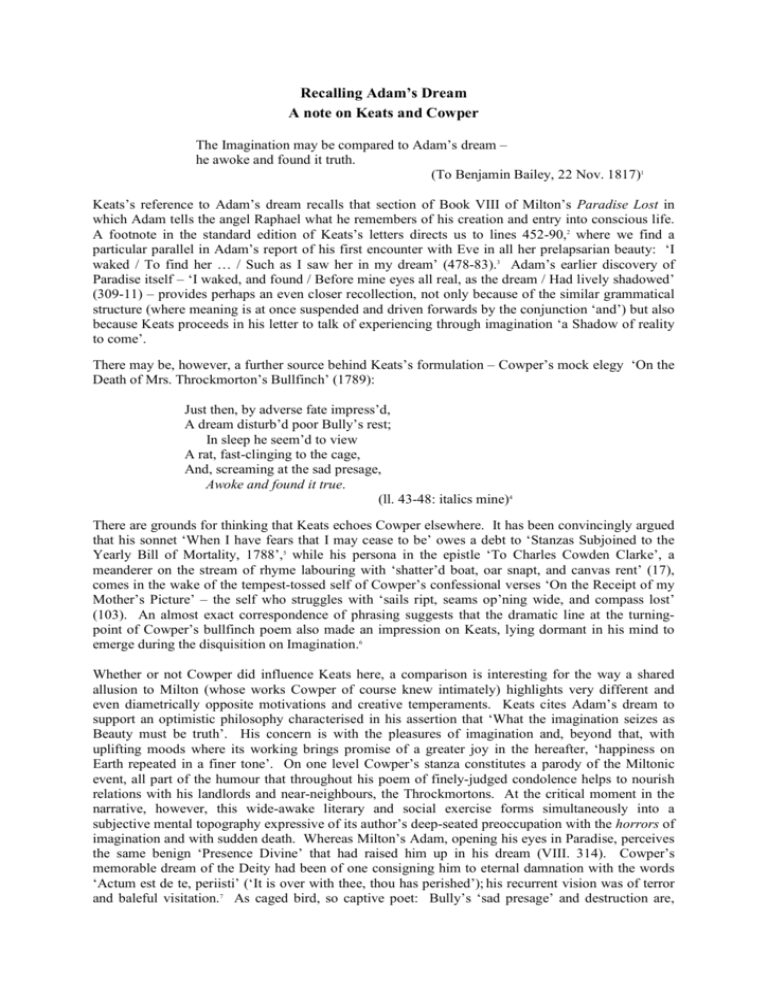
Recalling Adam’s Dream A note on Keats and Cowper The Imagination may be compared to Adam’s dream – he awoke and found it truth. (To Benjamin Bailey, 22 Nov. 1817)1 Keats’s reference to Adam’s dream recalls that section of Book VIII of Milton’s Paradise Lost in which Adam tells the angel Raphael what he remembers of his creation and entry into conscious life. A footnote in the standard edition of Keats’s letters directs us to lines 452-90,2 where we find a particular parallel in Adam’s report of his first encounter with Eve in all her prelapsarian beauty: ‘I waked / To find her … / Such as I saw her in my dream’ (478-83).3 Adam’s earlier discovery of Paradise itself – ‘I waked, and found / Before mine eyes all real, as the dream / Had lively shadowed’ (309-11) – provides perhaps an even closer recollection, not only because of the similar grammatical structure (where meaning is at once suspended and driven forwards by the conjunction ‘and’) but also because Keats proceeds in his letter to talk of experiencing through imagination ‘a Shadow of reality to come’. There may be, however, a further source behind Keats’s formulation – Cowper’s mock elegy ‘On the Death of Mrs. Throckmorton’s Bullfinch’ (1789): Just then, by adverse fate impress’d, A dream disturb’d poor Bully’s rest; In sleep he seem’d to view A rat, fast-clinging to the cage, And, screaming at the sad presage, Awoke and found it true. (ll. 43-48: italics mine)4 There are grounds for thinking that Keats echoes Cowper elsewhere. It has been convincingly argued that his sonnet ‘When I have fears that I may cease to be’ owes a debt to ‘Stanzas Subjoined to the Yearly Bill of Mortality, 1788’,5 while his persona in the epistle ‘To Charles Cowden Clarke’, a meanderer on the stream of rhyme labouring with ‘shatter’d boat, oar snapt, and canvas rent’ (17), comes in the wake of the tempest-tossed self of Cowper’s confessional verses ‘On the Receipt of my Mother’s Picture’ – the self who struggles with ‘sails ript, seams op’ning wide, and compass lost’ (103). An almost exact correspondence of phrasing suggests that the dramatic line at the turningpoint of Cowper’s bullfinch poem also made an impression on Keats, lying dormant in his mind to emerge during the disquisition on Imagination.6 Whether or not Cowper did influence Keats here, a comparison is interesting for the way a shared allusion to Milton (whose works Cowper of course knew intimately) highlights very different and even diametrically opposite motivations and creative temperaments. Keats cites Adam’s dream to support an optimistic philosophy characterised in his assertion that ‘What the imagination seizes as Beauty must be truth’. His concern is with the pleasures of imagination and, beyond that, with uplifting moods where its working brings promise of a greater joy in the hereafter, ‘happiness on Earth repeated in a finer tone’. On one level Cowper’s stanza constitutes a parody of the Miltonic event, all part of the humour that throughout his poem of finely-judged condolence helps to nourish relations with his landlords and near-neighbours, the Throckmortons. At the critical moment in the narrative, however, this wide-awake literary and social exercise forms simultaneously into a subjective mental topography expressive of its author’s deep-seated preoccupation with the horrors of imagination and with sudden death. Whereas Milton’s Adam, opening his eyes in Paradise, perceives the same benign ‘Presence Divine’ that had raised him up in his dream (VIII. 314). Cowper’s memorable dream of the Deity had been of one consigning him to eternal damnation with the words ‘Actum est de te, periisti’ (‘It is over with thee, thou has perished’); his recurrent vision was of terror and baleful visitation.7 As caged bird, so captive poet: Bully’s ‘sad presage’ and destruction are, psychologically understood, Cowper’s nightmare of how his own end will come. There is a bird in Keats’s letter as well as in Cowper’s poem. The young writer eventually describes to Bailey his habit of identifying with the phenomena around him, so that ‘if a Sparrow come before my Window I take part in his existence and pick about the Gravel’. Such sensation of ‘the present hour’, he claims, ‘will always set me to rights’, dissolving the pressures of self-consciousness and ‘Misfortune’. Cowper’s identification with the unfortunate Bully, the doomed creature that comes to stand as his double, is a more complex affair determined by these very pressures and involving a mixture of impulses. He too takes pleasure in the moment – strangely so, since his subject is a scene of death. This response can be explained, however, as a melancholy delight in the fact that death is after all an escape from uncertainty. Pitched between horror and glee, the account of Bully’s fate projects not only the secret fears of the poet shut up in a fool’s paradise of domestic calm (so markedly Cowper’s milieu at the Lodge, Weston Underwood, on the Throckmorton estate) but also the knowledge that to be broken in upon is a species of breaking out. Mrs Throckmorton’s improvident choice of a wooden rather than wire cage – ‘His teeth were strong, the cage was wood – / He left poor Bully’s beak’ (53-54) – turns out to be in a sense a happy oversight. From Cowper’s point of view, as one himself awaiting the fatal hour, metal bars would only have prolonged the issue.8 The experience of sharing in the existence of the sparrow outside his window is a good example of the kind of event Keats has in mind in his celebrated theory of ‘negative capability’, the type of creative process where an author negates his or her own identity and assumes that of another person or thing, which he expressly distinguishes from the ‘egotistical sublime’ or genius which draws all to its own centre.9 Cowper’s poem inclines to this latter end of the spectrum. Though there is nothing ‘sublime’ about it, except in burlesque form (‘Where Rhenus strays his vines among, / The egg was laid from which he sprung … ’ [7-8]), it is certainly ‘egotistical’ in the way his deep-set obsession infuses the drama of Bully’s passing. We may, moreover, also contrast the two writers in terms of the therapeutic gains intrinsic to their respective acts of creativity. For Keats problems evaporate as he loses himself in the life of his avian visitor. In Cowper, on the other hand, we find a positive release or letting out of emotion, both in the catharsis of his envisioning of an abrupt catastrophe, as we have seen, and in the humour of the mock-heroic play (‘Maria weeps – The Muses mourn’ [61]), which throughout the poem yields diversion for the long-troubled poet as well as for his bereaved addressee.10 Whatever personal or individual benefits Keats and Cowper here ascribe to imagination, however, they offer at the same time configurations of polarities in our collective inner lives. Keats expresses the proverbial yearning to be free as a bird. Cowper touches the darker reaches, transmuting the reassuringly familiar into an unsettling landscape of closed spaces (house, drawing-room, cage) where security is an illusion,11 sinister forces roam, ironies abound (the ‘smoothest-shaven wood’ was preferred to steel or brass because it would not damage Bully’s feathers [23-30]), and the only certainty is death itself – and where bad dreams can come disastrously true. How far the dominant metaphors of these complementary passages in literature – confinement and flight – underlie or shape our ways of thinking about human existence is a question for another occasion.12 Vincent Newey NOTES 1. For Keats’s letter to Bailey see The Letters of John Keats, ed. Hyder E. Rollins, 2 vols (Cambridge, Mass.: Harvard University Press, 1958), I, 183-87. 2. Letters, I, 185 (note 2). 3. The Poems of John Milton, ed. John Carey and Alastair Fowler (London: Longmans, 1968), p. 840. Subsequent references are bracketed in the text as line numbers. 4. Cowper: Poetical Works, ed. H.S. Milford, 4th edn revised Norma Russell (London: Oxford University Press, 1967), p. 384. References to Cowper’s poetry are from this edition. 5. See T.O. Mabbott, ‘Keats and Cowper: A Reminiscence?’, Notes and Queries, 175 (3 September 1938), 170. 6. Keats mentions Cowper once by name, when reporting in a journal letter of February 1818 that he has just attended William Hazlitt’s lecture on Thomson, Cowper and Crabbe, in which the first two were ‘praised’ and the third received ‘an unmerciful licking’ (Letters, I, 227). Subsequently published in his Lectures on the English Poets (1818), Hazlitt’s appraisal of Cowper includes substantial quotation from The Task and other works, though nothing from the pieces I have cited as likely sources of influence on Keats. The singular pathos of ‘On the Receipt of my Mother’s Picture’ is noted but attracts no supporting evidence either through argument or from the text. Hazlitt’s positive interest in this poem can in any case only have confirmed, rather than originated, Keats’s, for the apparent reverberation of Cowper’s image of the distressed voyager in the verses to Cowden Clarke comes two years earlier (see Letters, I, 109). It is quite possible, of course, that Keats came across Cowper’s lines to his mother and those on Mrs Throckmorton’s bullfinch in the same volume. 7. ‘Actum est de te, periisti.’ Cowper quotes these words – the sentence hanging over him – in one of several letters to John Newton refusing spiritual consolation (21 August 1781: The Letters and Prose Writings of William Cowper, ed. James King and Charles Ryskamp, 5 vols (Oxford: Clarendon Press, 1979-86), I, 510). Along similar lines, for example, he describes to his mentor the constant oscillation in his mental life between illusory hope and inescapable despair and foresees only one conclusion: ‘When I have thought myself falling into the abyss I have been caught up again; when I have thought myself on the threshold of a happy eternity, I have been thrust down to Hell. … I have no expectation but of sad vicissitude, and ever believe that the last shock of all will be fatal’ (2 September 1788: Letters and Prose Writings, III, 209). Interestingly, this passage echoes an important scene, not in Paradise Lost, but in the other great classic of the Puritan imagination – the damnation of the reprobate, Ignorance, at the close of Part One of Bunyan’s Pilgrim’s Progress, where the narrator sees in his dream that ‘there was a way to Hell, even from the Gates of Heaven’. It should be pointed out that Cowper’s starkest expression of personal dereliction lies in the stanzas beginning ‘Hatred and vengeance, my eternal portion’, in which he brands himself ‘Damn’d below Judas’ (l. 5) and speaks of the living hell of being ‘fed with judgment, in a fleshly tomb … / Buried above ground’ (ll. 19-20). 8. There is a similar synergy of the relief and the dread of finality at the climax of ‘The Castaway’, where the ailing Cowper thinks of his own struggle and end as he contemplates those of the ‘outcast’ mariner: ‘For then, by toil subdued, he drank / The stifling wave, and then he sank’ (ll. 47-48). The dying fall of ‘sank’ is a note that at once laments and relaxes. 9. To Richard Woodhouse, 27 October 1818: Letters, I, 386-88. 10. As early as ‘Epistle to Robert Lloyd, Esq.’, written in 1754, Cowper talks about the importance of writing as a bulwark against the ‘fierce banditti’ (l. 19) of melancholia. 11. This is another recurrent theme in Cowper’s writing. Thus he observes in a letter to William Unwin that ‘We are never more in danger than when we think ourselves most secure’ (3 August 1782: Letters and Prose Writings, II, 68). The truth of this is amply borne out by such diverse events in his poems as the sinking of the Royal George and all its crew by a land breeze when the warship was apparently safe at anchor (‘Toll for the brave’) or the invasion of the garden at Orchard Side by a viper (‘The Colubriad’). 12. W.B. Carnochan, Confinement and Flight: An Essay on English Literature of the Eighteenth Century (Berkeley: University of California Press, 1977) provides instructive insights into this topic.
